As you can guess, antique piano prices widely vary, depending on the model and brand you choose and its age, condition, and size. Since thousands of pianos have been manufactured during the past few centuries, you can’t find a comprehensive guide for all models.
However, you can roughly estimate a piano value by following a few general guidelines. The first thing to do is recognize the instrument type, check its condition and restoration level, and determine the price range. Be aware that it can go from several hundred to tens of thousands of bucks.
Antique Piano Value Guides
It is practically impossible to determine the piano value without seeing and checking it. Therefore, these prices can give you only a clue what to expect.
Remember that you always need to add at least 10% to 50% to the piano owner’s price if you decide to purchase it from a dealer. As expected, numerous things determine antique piano price, including:
Age
To make things clear, the term ANTIQUE is a bit different for pianos. So, vintage pianos are those created from 1945 to 1985, while experts consider only pianos made before the Great Depression antiques.
Finally, pianos from the 80s and the 90s are considered modern. So, you can buy a model from the late 1920s to 1930s and be sure that it is the right antique thing.
However, these old instruments need to be beautifully designed, handcrafted, and ornate. The most spectacular is probably those decorated in the 1800s.
Average antique piano prices |
||||
| Age | Piano type | Condition | ||
| Poor | Average | Factory-new to restored | ||
| 1880 to 1900 | Grand piano | $1,200 to $3,000 | $3,500 to $8,000 | $28,000 to $55,000 |
| 1900 to 1915 | Grand piano | $1,000 to $2,500 | $3,000 to $6,000 | $22,000 to $44,000 |
| 1915 to 1935 | Grand piano | $800 to $1,500 | $2,500 to $4,500 | $20,000 to $31,000 |
| 1840 to 1890 | Square grand piano | $1,000 to $2,500 | $3,500 to $6,500 | $31,000 to $55,000 |
| 1865 to 1915 | Victoria pump organ | $1,000 to $1,500 | $2,500 to $4,500 | $7,000 to $11,000 |
| 1840 to 1875 | Melodeon | $800 to $1,500 | $2,000 to $4,000 | $7,000 to $9,500 |
| 1850 to 1880 | Grand piano | $1,500 to $3,500 | $4,000 to $10,000 | $38,000 to $82,000 |
| 1850 to 1880 | Upright piano | $400 to $1,200 | $2,000 to $8,000 | $18,000 to $27,000 |
| 1880 to 1900 | Grand piano | $1,200 to $3,000 | $3,500 to $8,000 | $28,000 to $55,000 |
| 1880 to 1900 | Upright piano | $300 to $1,100 | $1,600 to $6,500 | $17,000 to $24,000 |
| 1900 to 1915 | Upright piano | $200 to $1,000 | $1,200 to $4,500 | $15,000 to $22,000 |
| 1915 to 1930 | Upright piano | $100 to $800 | $1,000 to $3,000 | $13,000 to $20,000 |
| 1905 to 1930 | Player piano | $500 to $1,000 | $2,000 to $6,500 | $22,000 to $28,000 |
Keep in mind that this instrument was invented in the early 18th century. In other words, the earliest antique piano you could find was about three centuries old.
Unfortunately, age alone won’t make this instrument highly valuable. Besides rare, historically important pianos built during WWII, the most pricey ones were those made in the 1920s and earlier.
The most appreciated antique pianos available on the current market were manufactured in the 19th century. Since they come in numerous styles and types, you can quickly pick out the one you like the best.
Piano depreciation
Depreciation is a helpful method for piano value estimation. It will be enough to find the same or comparable new piano and check its price.
Piano depreciation value |
|
| Age | % of new price |
| 1 year | 85% |
| 2 years | 82% |
| 3 years | 80% |
| 4 to 5 years | 74% |
| 6 to 8 years | 67% |
| 9 to 10 years | 62% |
| 11 to 15 years | 52% |
| 16 to 20 years | 43% |
| 21 to 25 years | 34% |
| 26 to 30 years | 27% (vertical) |
| 30 to 70 | 30% (grand) |
| 35 to 70 | 20% (vertical) |
After determining your instrument’s age, you can effortlessly calculate the price for an average-quality antique piece in decent condition.
Style
Nowadays, people often purchase pianos as furniture pieces because of their beauty. Some old instruments are virtually worthless, while others can reach enormous sums of money.
In most cases, the price will depend on the piano style. You can find antique pieces in a few categories, depending on their size:
Square grand pianos – No one has produced this piano type in the last 125 years, so all available are antiques. Unfortunately, modern piano tuners have no clue how to restore them, so most are not in usable condition and are entirely worthless.
Grand pianos – These instruments are classic. You can find them in three sizes, baby grand (5 feet/1.5 m), parlor grand (7 feet/2.2 m), and concert grand (10 feet/3 m) pianos.
Antique piano prices Chart |
||
| Age | Piano type | Price |
| 5 to 10 years | Steinway & sons | $60,000 to $90,000 (80% of new) |
| 10 to 20 years | Steinway & sons | $45,000 to $70,000 (60 to 70 % of new) |
| 20 to 30 years | Steinway & sons | $40,000 to $60,000 (50% of new) |
| 40+ years | Steinway & sons | $1,000 to $15,000 |
| 5 to 10 years | Known European make | $10,000 to $50,000 |
| 20 to 40 years | Known European make | $1,000 to $20,000 |
| 40+ years | Known European make | Up to $20,000 |
| 10 to 20 years | Yamaha/Kawai/Samick | $2,000 to $20,000 |
| 20 to 30 years | Yamaha/Kawai/Samick | Up to $5,000 |
| 30+ years | Yamaha/Kawai/Samick | Up to $400 |
| 40+ years | No longer produced American piano | Up to $5,000 |
Upright piano – This model was invented in 1826 and became popular because of its practical size and affordable price.
However, you should be prepared that they are far cheaper than antique grand pianos. The only exceptions are historically significant instruments and those played by famous musicians.
Mirror piano – This instrument created during WWII features a few parts replaced with mirror paneling. Even though it can be an interesting piece, its value is only a few hundred dollars.
Upright piano prices |
|
| Age | Retail price |
| 10 to 20 years | $4,000 to $10,000+ |
| 20 to 30 years | $3,000 to $8,000+ |
| 30 to 40 years | $1,000 to $2,000+ |
| 40+ years | $500 to $1,500+ |
A high-end upright piano’s price range is from $10,000 to $25,000, while you need to set aside about $3,000 to $6,000 for an average model.
On the other hand, a grand piano of the lowest grade will cost approximately $7,000 to $30,000. Antique grand piano models, such as Steinway, Yamaha, and Bosendorfer, typically reach $65,000 to an astonishing $195,000.
Condition
After three decades in use, pianos lose their musical integrity, and those older than forty years are worthless. In some cases, they can have negative value because of non-functional ones’ removal and disposal.
On the other hand, the professional restoration will increase its value. That is why a condition is crucial when choosing this instrument.
Mint – This piano was rebuilt and refinished, looking and playing as new.
Like new – Such an instrument looks beautiful without stains and scratches. Although you can notice slight signs of use, it is in excellent mechanical condition.
Excellent – There is no need to reconstruct this piano since it looks nice and comes without significant signs of wear, rust, or damage. Some tiny scratches in the wooden parts won’t affect its quality.
Very good – This piano comes without significant mechanical problems, but its look is not perfect. You can notice some stains, scratches, and minor damage on the surface.
Good – Be prepared that this instrument requires some reconditioning. It can also come with scratches, dents, and ugly stains.
Fair – Such a piano needs professional repair because of mechanical defects. It is full of scratches, chips, and dents, plus it sometimes has warped parts and chipped ivory. However, you can still use it for playing.
Be aware that Steinway & Sons grand pianos are the one exception to the rule, and these instruments retain residual value despite age and poor condition. The secret is in a unique design that allows rebuilding, restoring, and replacing components.
The company provides all necessary parts and experts who can high-quality restore every instrument they ever made. However, you should be aware that it is a costly and complicated job, making the residual value limited for repaired pianos.
Brand
You can find numerous piano manufacturers making these instruments during the 19th century. They are not of the same quality, so their prices nowadays will be aligned accordingly.
Piano manufacturers worldwide |
||
| Founding year | Company | City |
| 1723 | Broadwood | London |
| 1777 | Erard | Paris |
| 1823 | Chickering | Boston |
| 1828 | Bosendorfer | Vienna |
| 1835 | Hallet & Davis | Boston |
| 1836 | Marshall & Wendell | Albany |
| 1839 | Knabe | Baltimore |
| 1841 | Becker | Moscow |
| 1842 | Stieff Chas. M. | Baltimore |
| 1851 | Vose & Sons | Boston |
| 1853 | Bechstein | Berlin |
| 1853 | Bluthner | Leipzig |
| 1854 | Mason & Hamlin | Boston |
| 1857 | Kimball | Chicago |
| 1859 | Story & Clark | Burlington |
| 1862 | Baldwin | Cincinnati |
| 1863 | Henry F. Miller | Wakefield |
| 1864 | Petrof | Hradec Kralove |
| 1864 | Lyon & Healy | Chicago |
| 1866 | Sterling | Derby |
| 1872 | Starr | Richmond |
| 1875 | Chase A.B. | Norwalk |
| 1875 | French Jesse | Nashville |
| 1880 | Ivers & Pond | Boston |
| 1883 | Everett | Boston |
| 1884 | Bush & Gerts | Rockford |
| 1885 | Schimmel | Leipzig |
| 1887 | Yamaha | Japan |
| 1888 | Lester | Philadelphia |
| 1900 | Hobart M. Cable | La Porte |
| 1901 | Apollo | DeKalb |
| 1901 | Bush & Lane | Chicago |
| 1903 | Cable Nelson | Chicago |
| 1904 | Gulbransen | Chicago |
| 1908 | American | Rochester |
Remember that pianos of famous brands, like Steinway, typically cost two to four more than other manufacturers’ models.
Serial number
You should never consider buying a piano without a serial number. It gives precise information on production year and manufacturer.
The stamp with a 5-digit number is typically hidden under the grand piano’s lid or the hood. It is easier with upright pianos since they always have the serial number on the back where the strings are.
19th-century piano manufacturers in New York |
|
| Founding year | Company |
| 1789 | Francis Bacon |
| 1823 | Brambach |
| 1836 | Lindeman |
| 1840 | Fischer J & C |
| 1840 | Hazelton Bros. |
| 1842 | Hardman |
| 1851 | Haines Bros. |
| 1852 | Weber & Co. |
| 1853 | Steinway |
| 1854 | Gabler |
| 1856 | Wurlitzer |
| 1857 | Steck George |
| 1861 | Behning |
| 1962 | Decker Bros. |
| 1863 | Mathushek |
| 1864 | Kranich & Bach |
| 1869 | Estey |
| 1869 | Krakauer |
| 1872 | Sohmer |
| 1873 | Wing & Son |
| 1878 | Wissner |
| 1880 | Cable |
| 1881 | Behr Bros. |
| 1889 | Ludwig |
| 1889 | Mehlin & Sons |
| 1892 | Becker Bros. |
| 1894 | Kohler & Campbell |
| 1896 | Waldorf |
| 1903 | Autopiano |
| 1916 | Ampico |
| 1932 | Aeolian |
Once you find the number, compare it with a catalog or the Clinkscale database that includes pianos from 1700 to 1860. The next step is to find a manufacturer.
You will need the catalog again, but this information is not free of charge. It seems that Pierce Piano Atlas is the most affordable source. If you can’t find a serial number, your best shot is to ask a professional to evaluate the instrument.
Original price
As I have already mentioned, the value of pianos made in the last century typically decreases in the appropriate percentage over time. Therefore, determining the instrument’s original price is an excellent starting point for evaluating its current value.
Restoration levels
Interestingly, restoration won’t negatively affect antique piano value. On the contrary, professional restoring can significantly increase its price, depending on the instrument’s age, condition, and restoration degree.
Remember that minor restoration that improves piano appearance and playability is beneficial for lesser-quality antique pianos. Only top-notch brand pianos, such as Steinway, will cost more even after a complete restoration.
Be aware that it is a complicated and costly procedure, particularly if you have an antique square grand piano. The problem is that no manufacturers have made it for more than a century. So, it is challenging to find original parts and an expert capable of repairing such an instrument.
Keyboard range and color
You can be pretty sure that your piano is an antique if it has the lowest note higher than the lowest A on modern instruments. Plus, most old models have fewer than 85 keys.
Particular rarities are pieces with reversed colors. Pianos with light-colored (white) accidentals and dark (black) naturals were standard in keyboards produced in the 18th century.
Interior reinforcement
Antique pianos typically come with an all-wood construction. You can sometimes see metal bars over the soundboard but never a full cast-iron frame.
Summary
Antique pianos are at least a century old, but their value doesn’t depend only on their age. In fact, they can be virtually worthless in poor condition, while well-preserved branded pieces can reach astronomical prices. If you decide to buy a piano with an average grade, you should be prepared to pay at least $2,500 for restoration.
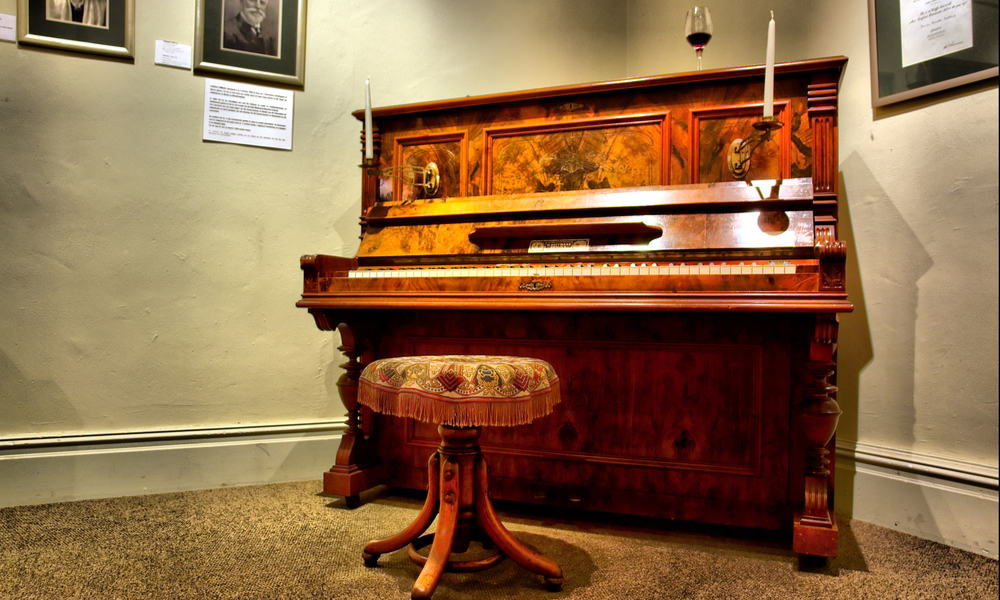
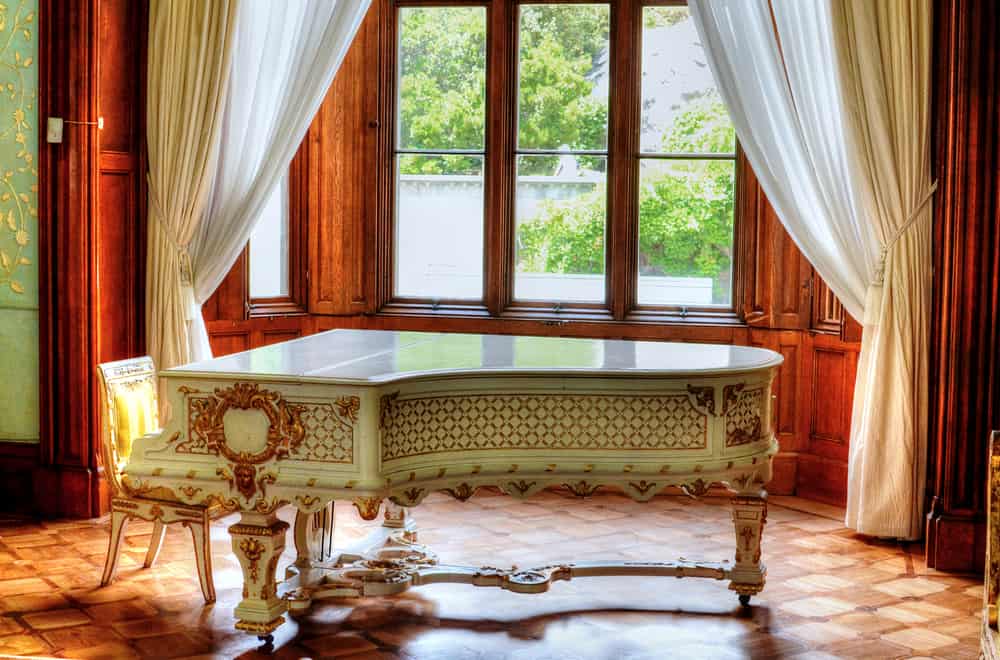
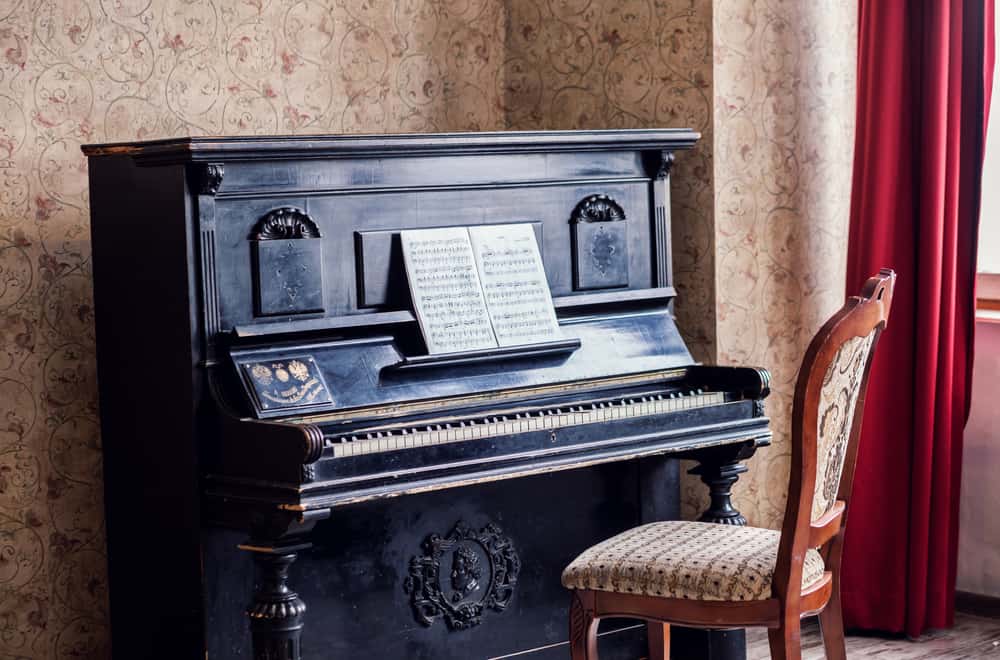
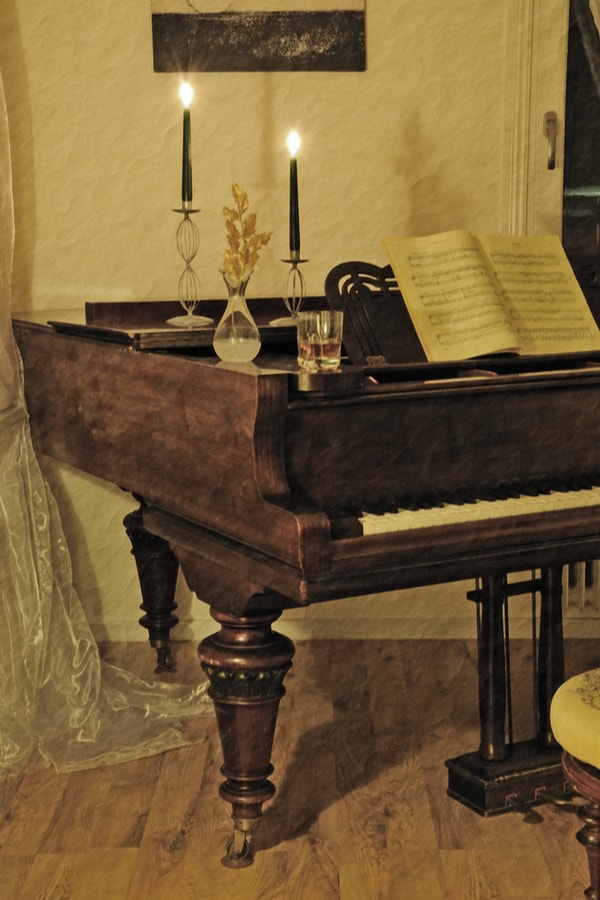
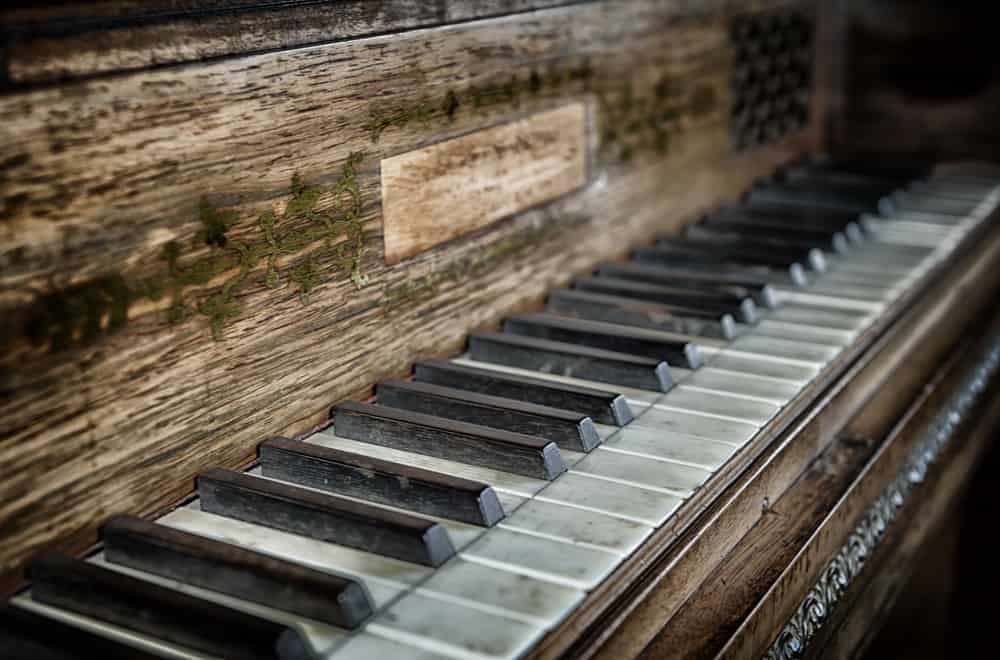
I have a baby upright grand piano. I think it is an “A.M. Benham.”, made in 1817. It is in good to very good condition, but it does need tuning. I still play on it occasionally. How much do you think it is worth, I am thinking about selling it. I can send pictures if that helps.